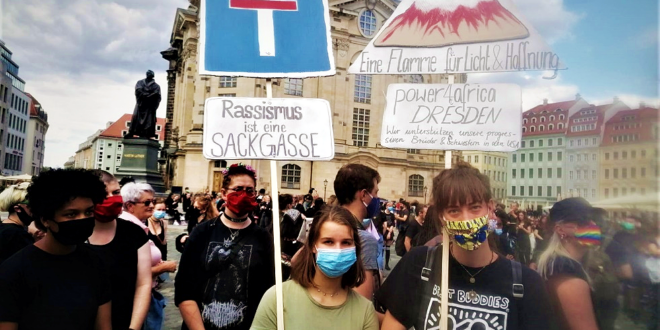Many institutions are currently making attempts to revisit their colonial past. In Dortmund, the LWL Museum Zeche Zollern recently opened the exhibition “Das ist kolonial” which will run until 26 October 2025. The exhibition is an attempt to make Westphalia’s role and (in)visible legacy of colonialism visible.
In Dresden, an exhibition entitled “Menschen anSchauen” at the Stadtmuseum ended on 7 July. The exhibition in Dresden not only features exhibits from the museum’s collection, but is accompanied by a curated programme that attempts to build a bridge from the past to the present.
In Dresden, as in many other towns and villages in the German Reich, people from (former) German colonies were exhibited in so-called “Völkerschauen” or “Menschenzoos” – human zoos. These shows, for the amusement of the general public, did not only take place during the German colonial era but lasted well into the 1940’s!
The exhibition in Dresden shows how this inhumane practice shaped the image of how a large part of society viewed Black people.

Few realise today how deep-rooted the impacts of the impressions and images from over 125 years ago still are. Accompanying the exhibition is a richly illustrated catalogue entitled “Menschen anSchauen” (“Looking at People”). The volume brings together many historical images that can be very painful to look at, especially for people affected by racism (trigger warning!). However, it is necessary to deal with such images if we want to come to terms with the inglorious era in German history when people from the colonies were paraded around like animals in a zoo.
The very first picture in the volume is an example of the schizophrenic white gaze. In a photo taken around 1909, a (nameless) Black man, presumably a Völkerschau participant, stands smoking a cigarette while leaning against a fence in front of a sign that reads “Achtung! Alle Tiere beißen.“ (Attention! All animals bite.) Back then, smoking a cigarette was a sign of modernity. The man in the picture is smoking one. At the same time, however, he is fenced in and the viewer is given a warning about dangerous animals. How does that fit together?
This volume not only brings together a whole lot of unpleasant pictures, but also provides some interesting long-forgotten biographies and calls for reflection on a practice that became a common leisure activity throughout the country thanks to the famous Hagenbeck brothers, among others.
By showing these painful pictures and biographies, the book also aims to show where racism originates from and how such shows contributed to the consolidation of white superiority and colonial continuities.
Even for people who are somewhat familiar with the subject, the book is likely to provide something new. For example, about the “Nubian” Hersi Egeh Gorseh from Somalia, whose story is hardly known even in Somalia today. Or the “black man” (his appearance was thus advertised in a local paper) Thomas Todmann, who was a frequent performer in various such shows.
Also revealing is a 6-page (!) overview of all the human zoo shows that took place between 1878 and 1934 in Dresden alone. There were almost 80 of them. This makes it clear that these performances were not a marginal phenomenon, but an integral part of a “culture” that anchored white superiority in the minds of a broad society.
The shows were rarely about getting to know foreign cultures. Instead, Black and Brown people were presented as different, dangerous and primitive. And at best as exotic. Thus, these shows helped to demean Black people and people of colour. Against the backdrop of increasing racism in Germany today, it is worth taking a look at this book, which clearly shows where the roots lie. This is not a pleasant read for either Black or white people. But it is certainly instructive.
Tina Adomako
 THE AFRICAN COURIER. Reporting Africa and its Diaspora! The African Courier is an international magazine published in Germany to report on Africa and the Diaspora African experience. The first issue of the bimonthly magazine appeared on the newsstands on 15 February 1998. The African Courier is a communication forum for European-African political, economic and cultural exchanges, and a voice for Africa in Europe.
THE AFRICAN COURIER. Reporting Africa and its Diaspora! The African Courier is an international magazine published in Germany to report on Africa and the Diaspora African experience. The first issue of the bimonthly magazine appeared on the newsstands on 15 February 1998. The African Courier is a communication forum for European-African political, economic and cultural exchanges, and a voice for Africa in Europe.


































